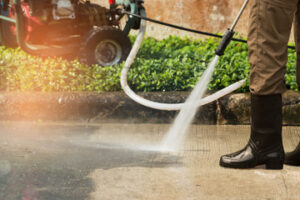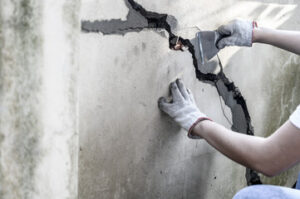Windsor Power Wash is a fast and effective way to clean surfaces. It is particularly useful for surfaces that have been stained or heavily contaminated with grime and oil.

The key difference between a power washer and a regular garden hose is that the water in a power wash is heated. This makes it more effective for cleaning stubborn stains, such as mildew, salt and grease.
Power washing uses a machine that blasts pressurized water at surfaces, which helps remove dirt, mildew and other contaminants. It’s a faster and more effective cleaning method than scrubbing by hand. Professionals use a variety of pressure settings, nozzle sizes and cleaners to accommodate different types of surfaces.
The force of the pressurized water dislodges and breaks apart dirt particles. This mechanical force is particularly effective on oil, grease and mud stains because it penetrates the pores of the surface and dissolves them. In addition, hot water blasts away moss, mildew and other growth that would otherwise damage or stain your property.
Aside from being unsightly, mildew and mold can be a health hazard. These substances irritate allergies and can cause long-term illness if people are exposed to them for extended periods of time. Regularly cleaning your property with a power washer can help prevent the buildup of these pollutants and keep your home or business healthier.
However, you should avoid using a power wash on delicate materials like wood or brick. The force of the water can strip granules from roof shingles, crack concrete and loosen adhesives along window frames. Additionally, you should not point a pressure washer at plants or shrubs because the pressurized water could damage them. Lastly, you should never point a power wash at your air conditioner, as the pressurized water can damage it or blow it off the wall.
Removes Allergens
During spring and summer, pollen, dirt, mildew, and mold spores can build up on outdoor surfaces like decks, patios, siding, and driveways. These contaminants can then be tracked into the home, causing poor air quality and exacerbating allergies. Scheduling regular Power Wash services helps to prevent the buildup of allergens and reduce the number that make their way indoors, making your home or business healthier for everyone inside.
Unlike traditional cleaning methods, which can use harsh chemicals that can harm plants and irritate sensitive noses, Power washing uses water as the primary cleaning agent. This method is safe for your lungs, eyes, pets, and the environment. Plus, since the runoff from a Power Wash doesn’t contain any harmful chemicals, it’s also good for the plants on your property.
Power Washing can be used on any type of surface on your property, including stone paths, sidewalks, and concrete or cement walkways. It can even be used on the outside of your house to remove dirt and grime, as well as mold and mildew that can trigger allergies in those living inside the home. This helps to ensure that these allergens are removed before they can cause problems, and it is a great way to start the allergy season off on the right foot. For those that suffer from allergies, this is a service that is definitely worth the investment!
Prevents Pests
The struggle to keep bugs away from your home can feel like a never-ending battle. In addition to costing money in exterminator fees, bug infestations can cause serious damage to your home and yard.
One way to prevent pests is through regular power washing. Dirt, dust, and organic material can build up on the surfaces around your home, creating a comfortable habitat for insects. These materials can also hide cracks, loose shingles, and other vulnerable areas that pests could use to enter your home. Power washing removes these layers and creates an inhospitable environment for pests, making your home less appealing as a place to live.
Some pests, such as stink bugs, love to nestle into the crevices of siding and brick. These critters can create huge colonies on the exterior of your house, which can be difficult to get rid of. Power washing your property regularly with high-pressure water can make these places uninhabitable for pests and give them a reason to look elsewhere for shelter.
Regular pressure washing of your property can also prevent these critters from building their homes in cracks, holes, and other areas where they can hide. It can also help keep dirt and other debris from accumulating, which can prevent a wide variety of pests, including termites, from damaging your home.
Besides cleaning, another important aspect of pest prevention is using a pheromone spray. These pheromones mimic the scent of certain plants and are designed to attract or deter specific pests. You can buy these pheromones online or at some garden centers. However, this method is not always effective and may harm the plants that produce them. The best way to use pheromones is to combine them with other methods of pest control, such as trimming bushes and trees away from your home, keeping the soil dry, and getting regular professional pressure washings.
Improves Indoor Air Quality
When dirt, mold, mildew and algae cling to exterior surfaces, they can become airborne, infiltrating indoor living spaces and triggering respiratory and other health concerns. Power washing eliminates these contaminants at their source, making them less likely to reappear. By making this service a regular part of your property maintenance plan, you can protect the health and longevity of your investment while creating a more pleasant and safer living environment for your family.
Dirty and cluttered outdoor spaces are more inviting to pests like rodents, insects and birds, which can carry diseases and contribute to allergies in your household. In addition to preventing organic matter from becoming airborne, a good power wash helps repel these unwanted invaders by making it more difficult for them to find safe places to nest and hide.
As the weather cools and you open windows, these allergens can drift indoors, aggravating breathing problems for people with asthma or other respiratory conditions. Source control – stopping pollutants at their source rather than merely increasing ventilation – is considered the most effective method for improving indoor air quality. Power washing can be a vital component of this strategy, particularly if the cleaner used is also safe for your plants, pets and wildlife as well as your household.
In addition to reducing the risk of health issues, regular power washing improves the appearance of your home or business, adding to its curb appeal and contributing to a positive image for your company or brand. It is also an important step before painting or staining outdoor surfaces as a clean surface allows the new coating to adhere more effectively and last longer. This is why many businesses and homeowners choose to include power washing as a part of their property maintenance plans.
Safe to Use
Power washing, also known as pressure washing, uses a specialized machine that blasts pressurized water to remove mildew, mold, dirt, moss, and other debris. It’s faster and more effective than hand scrubbing and can help prevent the build-up of these contaminants around your home.
However, if it’s not used correctly, power washing can damage surfaces like vinyl siding and brick or strip granules from roof shingles. It can also dislodge or loosen adhesives along window frames and cause messy splatter. If you’re planning on doing your own power wash, follow these tips to get the most out of it:
Start with the lowest setting. Use the right nozzle size and angle for the surface. Use a fan-shaped nozzle instead of a pinpoint nozzle to avoid damage. Use a detergent designed specifically for power washing. Avoid spraying other people or animals with the power washer, and always be cautious around electricity service feeds and electric meters.
If you’re not comfortable using a power washer, it’s best to hire an expert. They’ll have the right equipment, time-saving tools, and crew to quickly complete the job while keeping you and your property safe. Plus, they’ll use environmentally friendly cleaners that protect your landscaping and minimize the impact on local water sources.


